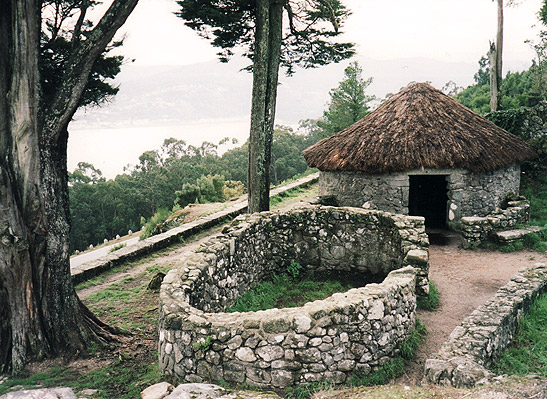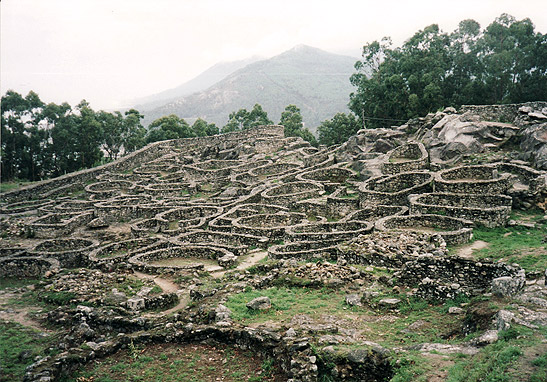 OK, so how would you like to live in a house like this? THIS is a "Must
See" Attraction in Northern Spain
I was part of a small group of US travel media who had just departed the magic of Portugal, and entered Northern Spain. It was a reasonably clear day and our tour bus began its climb up a steep, twisting and constantly turning road, that seemed to cling for all its worth to the mountain on which it was built, until it reached the top at (I'd guess) around at least three thousand or more feet in height. We rounded a curve and there, over to our right was (as you see from my photo) a series of stone circles. My instantaneous thought on seeing what lay before us, made me think it looked as if some giant prehistoric monster in centuries past, had seen a cluster of stone dwellings and decided it didn't like what it saw, and chose to chop off everything it could until they were down to ground level. In my travels around the world, I had never been so riveted by what I saw before me, and wondered why the Spanish had not - at least to my knowledge - made this more of a "Must See" tourist attraction. The location is the Galicia area of Spain, and the stone structures are to be found in a pre-Roman village called the Castro de Santa Tegra. What I thought was even more incredible, was that this site was only discovered by accident in 1913 when work was begun to make a road from the nearby town of A Guarda (Pontevedra) to the top of the hill. Given what it means to archeologists and the tourist trade, it was named a Historic Artistic Monument in 1931. The view from the top is stunning, as it looks down on the mouth of the Rio Mino River that flows out into the Ocean, and then the scenery over to the right is equally gorgeous. I'm not much of an archeological buff as regards ancient ruins, but seeing this patchwork quilt of stones, and the way they were laid out, is a mesmerizing sight, and a veritable goldmine for creative photography and videos. In order to show tourists what the houses looked like before they were destroyed, there is a reproduction over to one side of this unique attraction. I was not able to find anyone who could tell me how they came to be destroyed and left in this eye catching layout. But it is an intriguing thought to contemplate how such a catastrophe happened, and how and why they were not located - by accident, for heavens sakes - until 1913. Most local officials I talked to said that the dwellings dated all the way back to Celtic times in the second century BC, and were used as family homes, with an average width of between 16 to 20 feet inside. As a travel journalist I would have loved to have been given more information about the Castro de Santa Tegra location, and wished there had been some sort of booklet on site handed out - but none were available. If I have any - and I wonder if this is the right word - complaints about such places in Europe, trying to find any information or even small flyers, is often impossible. Yes, of course they love US and British tourists, but they don't seem to have the same passion (or is it interest?) about tourist information on such attractions, as we do in the USA. If you do find information, it's usually either in the language of the country, or a few facts printed in German, French and Spanish - but seldom, if ever, in English. That said, and because I urge you to visit this truly spell binding attraction when you're in Northern Spain, or hopping on over from nearby Portugal, the best place for information is to Google it and just type in - as I did - "Castro de Santa Tegra" and a whole lot of nifty websites will appear. You can also contact the Spanish Tourist website at www.spain.info or just type in "The country of Spain," and you'll see a whole page of interesting websites. I'd really like to hear from you on this Spanish story, as well as your comments on some of my other features on this website, and hope you'll contact me at jdcradio@cox.net.
|
